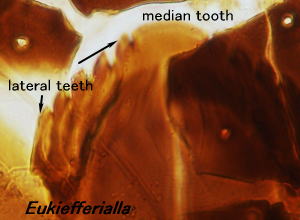
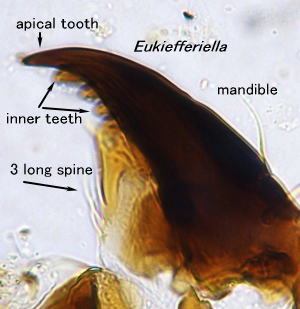
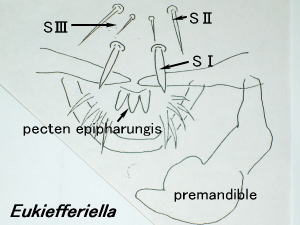
the form of mentum is various. Like an upper figure , median tooth is broad arc-shaped or the tooth is deeply incised in the center. Lateral teeth with 5 pairs,
Pecten epipharyngis 3 scales ,simple. Premandible semi -circle.B
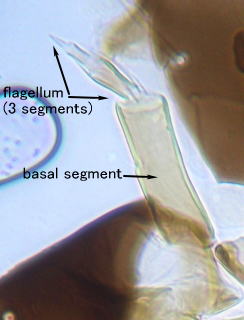
R|V@Eukiefferiella group@
@@@ mentum with 11 teethisomeone with 2 median teethj@@@@@@@@@return to Orthocladiinae group
Eukiefferiella@@Paraphaenocladius @@Parametriocnemus
@ Paracricotopus@@Tvetenia@ @Cardiocladius@ @@Thienemannia@@@@Chaetocladius
| @ | mentum | mandible | antenna | ST | other character |
| Eukiefferiella | Median tooth wide or two teeth . Lateral teeth with 5 pairs |
3 serrated on inner side of mandible, length of teeth various. | Almost of them 5 segments. claripennis type has 4 segments |
slightly broad needle shape | @@ |
| Paraphaenocladius | Median tooth wide, someone with concave at center Lateral teeth 5 pairs. Ventromental plate double, broad oval. |
Without serrated | 5 segments | broad plumose | Preanal segment curved over remaining segments, directing procercus with anal setae posteriorly and posterior parapods ventrally. |
| Parametriocnemus | With two median teeth. Lateral teeth 5 pairs . Ventromental plate oval |
Without serrated | 5 segments , segment 3` 5 short | broad plumose | Anal tubules sharp cone. |
| Paracricotopus | Median tooth three times of 1st. lateral tooth. Lateral teeth 5 pairs. |
Without serrated Tip of subdentalis curved |
5 segmentst , blade on segment 2 long. | divided or long plumose |
Two pairs of anal tubules longer than posterior parapods. |
| Tvetenia | Someone of Tvetenia ,median tooth with a concave at center. | 1`R@serrated on inner side. | 5 segmentsA | nomal or divided into 3 |
Tip of eye spot sharp, 1 pair. : abdominal segments with relatively long setae. |
| Cardiocladius | The point of median tooth flat as cut. | Some of them with Q`R serrated | 5 segments | strong , short needle shape | Anal setae : 2 strong and long ; 2 thin and short. |
| Thienemannia | Median tooth with deep concave and visible to two. Lateral teeth 5 pairs. |
With 4 inner teeth. seta subdentalis sharp. | 5 segments : antenna ratio 1.0 |
STplumose. rUnomal |
Premandible divided., brush well developed. |
| Chaetocladius | Since a form is various ,it is written on the clause of Chaetocladius . | ||||
As for Eukieffriella, there are many kinds (aproximatelly 50 kinds are comfirmed), and as for those most, the length is 3-5mm. The color of those bodies are yellow- green to violet, various. .
 |
 |
 |
| Because many kinds as for Eukiefferiella the form of mentum is various. Like an upper figure , median tooth is broad arc-shaped or the tooth is deeply incised in the center. Lateral teeth with 5 pairs, |
Edge of inner side of mandible with 3 long or short spines. This is the feature of Eukiefferiella. | Both rTand rUsimple., long and strong. Pecten epipharyngis 3 scales ,simple. Premandible semi -circle.B |
 |
||
| Almost of Eukiefferiella with 5 segments, but in E. claripennis group with 4 segments. | ||
Body length R`Umm. Pale green `graysh green. Several kinds of Paraphaenocladius distributed in the country.
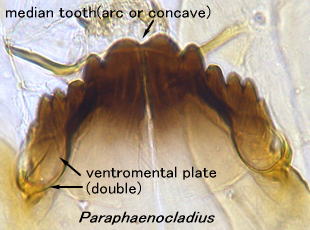 |
|
| Ventromental plate double. It is the feature of this larva. | |
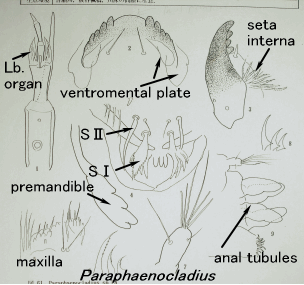 |
EMedian tooth of mentum arc or concave. Lateral teeth 5 pairs. Ventromental plates double. EAntenna with 5 segments, antnnal ratio various. Lauterborn's organ comparatively large EMandible: with 3 inner teeth. seta subdentalis short spin. ErT: plumose @rU:thick, long @Pecten epipharyngis simple 3 scales. EPremandible divided into R`S. EPosterior parapod and anal tubules under 12th body segment. EAnal setae U`7. Length of procercus various. |
Body length 4`10mm , comparatively large size, graysh green. 10 or more kinds of Parametriocnemus distributed widely in the country.
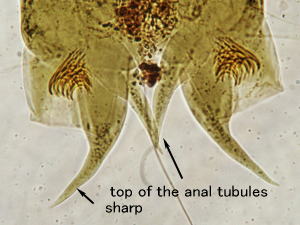 |
||
| Ventromental plate single, with two medianteeth | 3rd`Tth segments of antenna short | Top of the anal tubules sharp, it is featue of this genus.. |
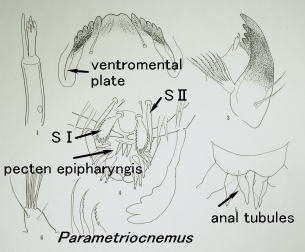 |
E@Mentum with 2 median teeth, lateral teeth 5 pairs.
Ventromental plate large, single. .E@Antenna 5 segments. Antenna ratio various. E@Inner teeth of mandible three. Seta subdentalis sharp or divited into 2`R E@rTplumose. rUsimple, long and strong. Pecten epipharyngis 3 scales. E@Premandible divited into 2`5. E@Anal tubules and posterior parapod nomal (differ from Paraphaenocladius .) E@Anal setae T`V. |
@ |
@@@@@@@@@@@@@@@@@@@@@@@@@@@@@@@@@@@@@@@@@@@@@@@@@@@@@@return to top of this page
Paracricotopus
Body length 2`5mm , graysh green `yellowish brown. Eye spot 1 pair. 10
or more kinds of Paracricotopus distributed widely in the country. Without noticeable seta.e on it.
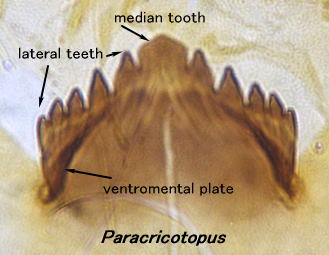 |
|
| Median tooth of mentum 2`R times of 1st. lateral tooth. Lateral teeth 5 pairs. Ventromental plate elongated. | Anal tubules longer than posterior parapod. Anal setae 3 long and thick ,and 1`2 short and thin. |
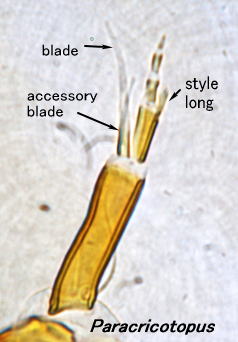 |
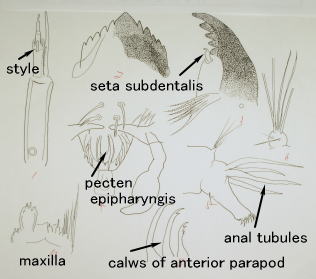 |
| Antenna with 5 segments. Antenna ratio 1.2`1.5. Style comparatively long. Ring organ@located near the bottom of basal segment. |
rTdivited or simple scale with thin hairs. rUlong needle shape. Pecten epipharyngis 3 long scales. Premandible simple. |
Body length S`Umm, body color grayish green . Eye spot 1 pair, pointed forward. Remarkable setae on every body segments. Several kinds of this genus caught in the country., distributed widly.
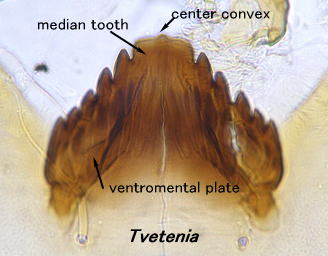 |
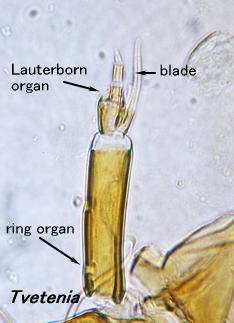 |
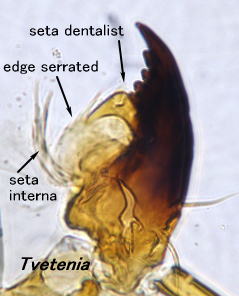 |
| Mentum: center of median tooth covex or concave.. Ventromental plate clear. |
Antenna with 5 segments. Antenne ratio 1.4`1.6. | Mandible: 3 inner teeth. Inner edge with 1`3 serrated. |
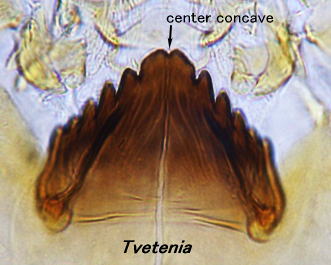 |
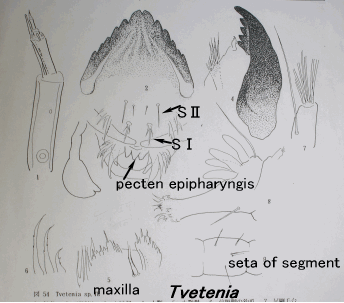 |
ESTFmany kinds divited into 3 , but some divited into comb teeth. shape. rU: simple ,thin. EPecten epipharyngis 3 scales. EOn every body segments remarkable simple setae EAnal setae U`V. |
@@@@@@@@@@@@@@@@@@@@@@@@@@@@@@@@@@@@@@@@@@@@@@@@@@@@@@@@@@@@@@@@@@@@@@@@@@@@@return to top of this page
Body length about 10 mm more or less. Dark green ` purple in color. About 10 kinds of this larva distributed widely in the country.
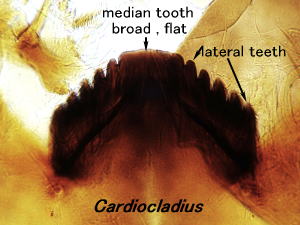 |
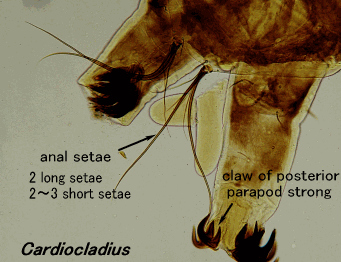 |
| Broad median tooth and 5 pairs of lateral teeth. Tip of .median tooth streight. Ventromental plte triangular . | Procercus short, 2 long, strong setae and 2 or 3 short thin setae. Anal tubules 2 pairs , short. |
| EMandible blackish brown with 4 inner teeth. Seta subdentalis short, pointed. EAntenna with 5 segments, antennal ratio 1.2`1.5. ErTnad rU both thick, short . Pecten epipharyngis 3 triangular . Tip of Premandible semicircular. |
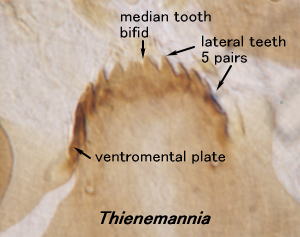 |
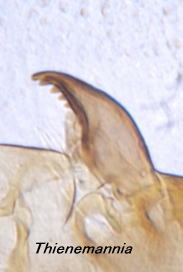 |
||
| Median tooth bifid , !st and 2nd lateral tooth the sane size. | Mandible: with 4 inner teeth. | ||
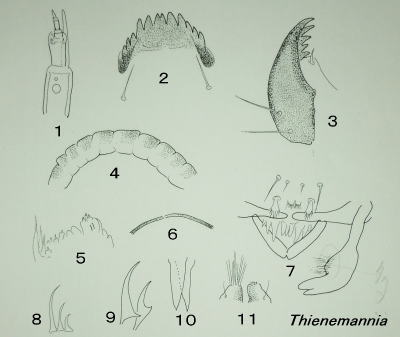 |
PFantenna QFmentum RFmanduble SFpattern on dorsal side of body segment TFmaxilla UFpostoccipital margin thin VFrTwith several teeth @@rU:long needle shape @@pecten epipharyngis :3 scale-like spines WFclaws of anterior parapod XFclaws of posterior parapod POF anal tubules PPFprocercus |
||
@@@@@@@@@@@@@@@@@@@@@@@@@@@@@@@@@@@@@@@@@@@@@@@@@@@@@@@@@@@@@@@@return to top of this page
Body length is about 5mm. The living body is blue purple` purple brown.
Labral lamella is various. Several kinds of Chaetocladius caught, but not a lot of individuals.
They are classified into three groups depending on the shape of the mentum, STand premandible.
| mentum | rT | premandible | |
| Chaetocladius (1) | Median tooth large, concave at center. Lateral teeth 5 pairs |
Divided into two deeply, and tips of them divided into several. ( see. Figure below) |
divided into two deeply |
| Chaetocladius (2) | Median tooth large, dome shape. Lateral teeth 5 pairs |
Divided into two deeply, and tips of them divided into several. ( see. Figure below) |
divided into two deeply |
| Chaetocladius (3) | Median tooth wide. Lateral teeth 5 pairs |
Scale shape, edge of them small serrated. | scale shape |
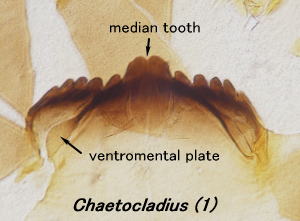 |
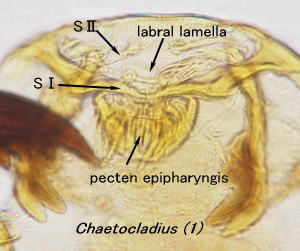 |
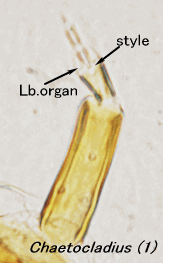 |
| Median tooth large, concave at center. | rU: simple, long and thin. Pecten epipharyngis 3 long scales. Labral lamella various. | Antenna with 5 segments. Lauterborn's organ and style slightly large. |
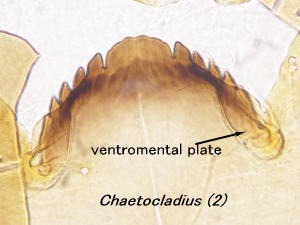 |
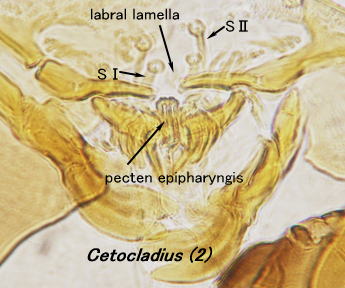 |
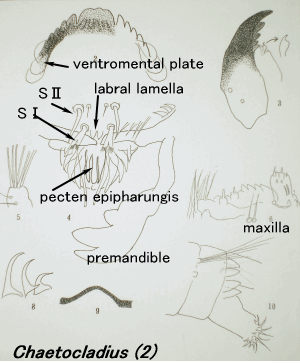 |
| Median tooth dome shape. Size various. | rU:long and thick. Pecten epipharyngis 3 long scales. Labral lamella various. | Chaetocladius (2) |
| EInner teeth of mandible 4. the 4th inner tooth fused with basal part. EAnal setae 6`V |